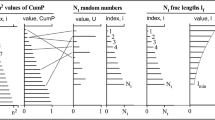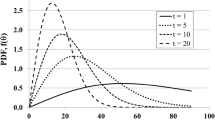Abstract
The influence that fractures exert on the permeability of a fractured rock is, to a large extent, controlled by the nature of the network formed by the fracture system. Here, the network properties of a two-dimensional natural pattern, mapped from the surface of a sandstone layer, are investigated and compared to those of realizations of spatially randomly distributed line segments with similar orientation and length distributions and line segment density (line length per unit area) to the natural pattern. These patterns are composed of clusters of varying size and shape, made up of interconnected fracture traces or line segments. Comparing the natural pattern with the realizations, the natural pattern was found to contain roughly half the number of clusters while the mass (total line length) of the largest cluster is approximately double that of the realizations. The size of the largest cluster controls the connectivity of the patterns, as can be seen by comparing the largest cluster of the natural pattern, which connects all four sides of the region, with those of the realizations, which are unconnected or connect only two sides. Cluster scaling characteristics were found to be similar in the natural pattern and the realizations and show a crossover from a dimension of one (their topological dimension) to two (the dimension of the embedding medium) at a point that corresponds to the fracture spacing. An investigation of the self-similarity dimension, using the box-counting method, showed similar characteristics with a broad transition zone between one- and two-dimensional behaviour at smaller box sizes. The patterns are therefore found to be non-fractal. The effect of the spatial distribution shown by the natural pattern is thus to modify the manner in which fractures are distributed among clusters, increasing connectivity (and permeability in the case of open fractures), but does not affect the cluster scaling characteristics or the self-similarity dimension of the fracture patterns.
Similar content being viewed by others
References
Balberg, I. (1986),Connectivity and conductivity in 2D and 3D fracture systems. InFragmentation, Form and Flow in Fractured Media (eds. Engelman, R., and Jaeger, Z) Annals Israel Physical Soc8, 89–101.
Balberg, I., andBinenbaum, N. (1983),Computer Study of the Percolation Threshold in a Two-dimensional Anisotropic System of Conducting Sticks, Physical ReviewB28, 3799–3812.
Barton, C. C., andLarsen, E. (1985),Fractal Geometry of Two-dimensional Fracture Networks at Yucca Mountain, Southwestern Nevada, Proc. Int. Symp. Fundamentals of Rock Joints, Björkliden, Sweden, 77–84.
Cheeney, R. F.,Statistical Methods in Geology (George Allen and Unwin, London 1983).
Chilés, J. P. (1988),Fractal and Geostatistical Methods for Modelling of a Fracture Network, Mathematical Geology20, 631–654.
Dverstorp, B., andAndersson, J. (1989),Application of the Discrete Fracture Network Concept with Field Data: Possibilities of Model Calibration and Validation, Water Resources Research25, 540–550.
George, A.,Computer Solution of Large Sparse Positive Definite Systems (Prentice Hall, Inc., USA 1981).
Hestir, K., andLong, J. C. S. (1990),Analytical Expressions for the Permeability of Random Two-dimensional Poisson Fracture Networks Based on Regular Lattice Percolation and Equivalent Porous Media Theories, J. Geophys. Res.95 (B13), 21,565–21,581.
Hirata, T. (1989),Fractal Dimension of Fault Systems in Japan: Fracture Structure in Rock Fracture Geometry at Various Scales, Pure Appl. Geophys.131, 157–170.
Mandelbrot, B. B.,The Fractal Geometry of Nature (W. H. Freeman and Company, New York 1983).
Okubo, P. G., andAki, K. (1987),Fractal Geometry in the San Andreas Fault System, J. Geophys. Res.92 (B1), 345–355.
Pike, G. E., andSeager, C. H. (1974),Percolation and Conductivity: A Computer Study, Phys. Rev.B10, 1421–1434.
Robinson, P. C. (1983),Connectivity of Fracture Systems—A Percolation Theory Approach, J. Phys. A: Math. Gen.16, 605–614.
Robinson, P. C. (1984),Connectivity, Flow and Transport in Network Models of Fractured Media, Ph.D. Thesis, Oxford University.
Skjeltorp, A. T.,Fracture experiments on monolayers of microspheres. InRandom Fluctuations and Pattern Growth: Experiments and Models (eds. Stanley, H. E., and Ostrowsky, N.) (Kluwer Academic Publishers, Netherlands 1988) pp. 170–175.
Snow, D. (1969),Anisotropic Permeability of Fractures Media, Water Resources Research5, 1273–1289.
Stauffer, D.,Introduction to Percolation Theory (Taylor and Francis, London 1985).
Steel, R. J. (1976),Devonian Basins of Western Norway—Sedimentary Response to Tectonism and to Varying Tectonic Context, Tectonophys.36, 207–224.
Stephens, M. A. (1970),Use of Kolmogorow-Smirnov, Cramer-Von Mises and Related Statistics without Extensive Tables, J. R. Statist. Soc.B32, 115–122.
Author information
Authors and Affiliations
Rights and permissions
About this article
Cite this article
Odling, N.E. Network properties of a two-dimensional natural fracture pattern. PAGEOPH 138, 95–114 (1992). https://doi.org/10.1007/BF00876716
Received:
Accepted:
Issue Date:
DOI: https://doi.org/10.1007/BF00876716




